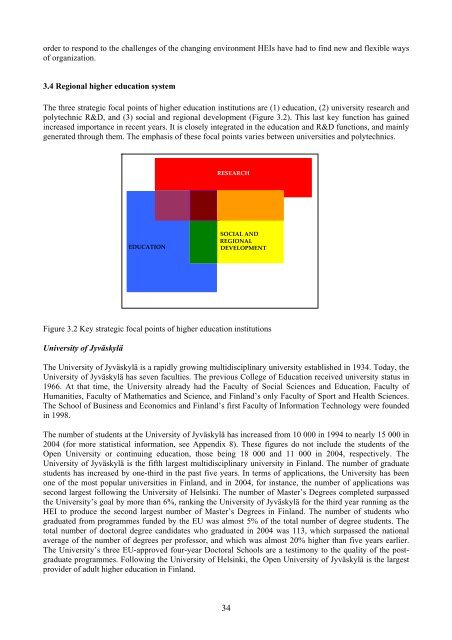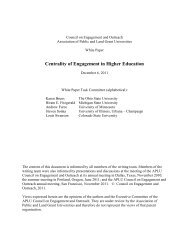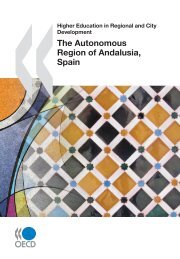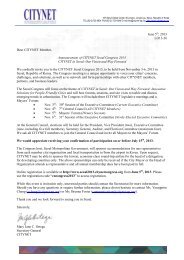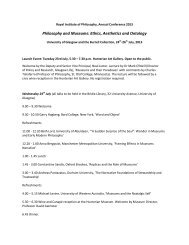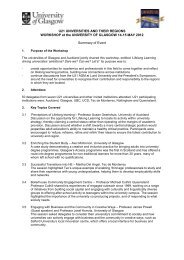According to a report published by the ministerial working group in 2001, the capacity for effectiveutilization of research findings is a requisite for efficient work both in ministries and at the government level.Achieving the aims set requires that decision-making on information and knowledge systems is sufficientlycentralized and the ministries are able to operate as a network. The Science and Technology Policy Councilof <strong>Finland</strong> emphasizes the growing role of ministries as strategic technology development agencies in theirown sectors. The Ministry of the Interior is responsible for the preparation of regional developmentobjectives together with the other ministries and <strong>Region</strong>al Councils.The <strong>Region</strong>al Centre Programme and Centre of Expertise Programme represent the key policy initiatives ofpromoting a more regionally oriented development. The Ministry of the Interior is the main responsibleauthority of the Centre of Expertise Programme, which started in 1994. It is a fixed-term special programmethat in accordance with the <strong>Region</strong>al Development Act aims to identify regional strengths and createeconomic growth based on existing knowledge and expertise. Locally, a key purpose of the Centre ofExpertise Programmes is to bring leading experts in research, education and private enterprises in a region ornetwork into close interaction. The national Committee, consisting of experts in the fields of economy,research and education, as well as professionals working in regional and local administration, monitors andcoordinates the activities relating to the programmes in different regions. The Committee also functions as awider forum for discussion regarding the development of regional innovation systems. In addition to theMinistry of the Interior, the other ministries involved in the programme include the Ministries of Labour,Education, Trade and Industry, Agriculture and Forestry, and Social Affairs and Health. The Centre ofExpertise Programme has proved to be a successful policy instrument. The <strong>Region</strong>al Centre Programme is aspecial government programme launched in accordance with the <strong>Region</strong>al Development Act. The Ministryof the Interior is in charge of the national co-ordination of the programme in cooperation with otherministries. The programme aims at the development of a network of regional centres based on the particularstrengths, expertise and specialization of urban regions of various sizes.The current government’s programme stresses the importance of localization in the globalized world. Astrong base of regional know-how, entrepreneurship and employment is seen to contribute to the economicgrowth of the whole country. One way to support regional competitiveness is to strengthen the regionaldevelopment role of higher education institutions. National higher education policy has changed in the pastyears, starting to emphasize the social and regional engagement of HEIs as part of the national innovationand competitiveness policy. The regional strategy for education and research of the Ministry of Educationpresents the visions and strategic policy lines, which underpin the efforts to boost the positive regional effectof education and research.According to the Science and Technology Policy Council of <strong>Finland</strong>, the growing role of HEIs in regionaldevelopment raises a challenge of merging national higher education policy and regional development policytogether in a rational and expedient way. Universities meet the full force of expectations for social, culturaland economic development. The universities and the whole research system should be able to combine indepthspecialized knowledge with versatile expertise for the benefit of users and in contracted research andin joint projects with them. A question partly relating to this is the future of higher education on the whole:how its different parts will take shape jointly and separately. (Science and Technology Policy Council of<strong>Finland</strong>, 2003.)Local level. At the local level, the <strong>Region</strong>al Councils (19 in <strong>Finland</strong>) are the authorities responsible forregional development under the <strong>Region</strong>al Development Act. The <strong>Region</strong>al Councils define the objectives ofdevelopment for the region and the ways and means of implementing them - together with other regionalauthorities and numerous partners. <strong>Region</strong>al development organizations and science parks are also importantactors in the regions and they devise their own strategies (key regional strategies are listed in Appendix 6).They have close contacts with universities, polytechnics, research units, large and small enterprises,financing bodies and providers of expert services.There is a complex interplay between higher education policy, science and technology policy and regionaldevelopment. Higher education institutions are expected to be active cooperation partners and mediators ofnew knowledge and know-how in their regions. The challenges raised from the environment have causedpressure both to the steering system of higher education institutions as well as to individual organizations. In33
order to respond to the challenges of the changing environment HEIs have had to find new and flexible waysof organization.3.4 <strong>Region</strong>al higher education systemThe three strategic focal points of higher education institutions are (1) education, (2) university research andpolytechnic R&D, and (3) social and regional development (Figure 3.2). This last key function has gainedincreased importance in recent years. It is closely integrated in the education and R&D functions, and mainlygenerated through them. The emphasis of these focal points varies between universities and polytechnics.RESEARCHEDUCATIONSOCIAL ANDREGIONALDEVELOPMENTFigure 3.2 Key strategic focal points of higher education institutionsUniversity of JyväskyläThe University of Jyväskylä is a rapidly growing multidisciplinary university established in 1934. Today, theUniversity of Jyväskylä has seven faculties. The previous College of Education received university status in1966. At that time, the University already had the Faculty of Social Sciences and Education, Faculty ofHumanities, Faculty of Mathematics and Science, and <strong>Finland</strong>’s only Faculty of Sport and Health Sciences.The School of Business and Economics and <strong>Finland</strong>’s first Faculty of Information Technology were foundedin 1998.The number of students at the University of Jyväskylä has increased from 10 000 in 1994 to nearly 15 000 in2004 (for more statistical information, see Appendix 8). These figures do not include the students of theOpen University or continuing education, those being 18 000 and 11 000 in 2004, respectively. TheUniversity of Jyväskylä is the fifth largest multidisciplinary university in <strong>Finland</strong>. The number of graduatestudents has increased by one-third in the past five years. In terms of applications, the University has beenone of the most popular universities in <strong>Finland</strong>, and in 2004, for instance, the number of applications wassecond largest following the University of Helsinki. The number of Master’s Degrees completed surpassedthe University’s goal by more than 6%, ranking the University of Jyväskylä for the third year running as theHEI to produce the second largest number of Master’s Degrees in <strong>Finland</strong>. The number of students whograduated from programmes funded by the EU was almost 5% of the total number of degree students. Thetotal number of doctoral degree candidates who graduated in 2004 was 113, which surpassed the nationalaverage of the number of degrees per professor, and which was almost 20% higher than five years earlier.The University’s three EU-approved four-year Doctoral Schools are a testimony to the quality of the postgraduateprogrammes. Following the University of Helsinki, the Open University of Jyväskylä is the largestprovider of adult higher education in <strong>Finland</strong>.34
- Page 1 and 2: OECD/IMHE ‐ Supporting thecontrib
- Page 3 and 4: SUMMARYTogether with 13 other regio
- Page 5 and 6: 8.2 Increasing the regional effecti
- Page 7 and 8: I INTRODUCTION1.1 Strengthening the
- Page 9 and 10: development. The aim is that region
- Page 11 and 12: The self-evaluation considered here
- Page 13 and 14: densely populated cities in Finland
- Page 15 and 16: 1,9 %1,7 %1,5 %1,3 %Population chan
- Page 17 and 18: The share of jobs in primary produc
- Page 19 and 20: New pillars of future’s developme
- Page 21 and 22: Jyväskylä0,60,91,11,0Central Finl
- Page 23 and 24: 2.4 Governance StructureMunicipalit
- Page 25 and 26: of its development outside the cent
- Page 27 and 28: III CHARACTERISTICS OF THE HIGHER E
- Page 29 and 30: continuing education and open unive
- Page 31 and 32: The Science and Technology Policy C
- Page 33: 3.2 Regional dimension within the n
- Page 37 and 38: 14001200Master's degreesDoctoratesN
- Page 39 and 40: 900800Youth graduatedAdult graduate
- Page 41 and 42: provide information for the basis o
- Page 43 and 44: CabinetParliamentSTPCSteering (andf
- Page 45 and 46: 5,04,0Billion euros3,02,01,00,083 8
- Page 47 and 48: The number of refereed articles is
- Page 49 and 50: Centre of expertisePaper industryBi
- Page 51 and 52: The Institute for Environmental Res
- Page 53 and 54: and systematic gradually progressin
- Page 55 and 56: are seen to be very important chann
- Page 57 and 58: Internal support units of HEIsThe F
- Page 59 and 60: of interviewed HEI staffs, the coop
- Page 61 and 62: areas of the region’s Centre of E
- Page 63 and 64: system of Jyväskylä and the HEIs
- Page 65 and 66: V CONTRIBUTION OF TEACHING AND LEAR
- Page 67 and 68: esources to establish new activitie
- Page 69 and 70: The main problem for the Finnish la
- Page 71 and 72: longer. 2.5% of the Jyväskylä Pol
- Page 73 and 74: activities. As a part of the new qu
- Page 75 and 76: education programmes consisting of
- Page 77 and 78: the TE-Centre of Central Finland an
- Page 79 and 80: practices in the provision of educa
- Page 81 and 82: Reason forskillupgradingDescription
- Page 83 and 84: Strengths+ HEIs are actively confro
- Page 85 and 86:
taxation, to lower the unemployment
- Page 87 and 88:
Box 6.2 The WIRE -projects: Support
- Page 89 and 90:
indoor ice-skating rink, the Rauhal
- Page 91 and 92:
The School of Cultural Studies at t
- Page 93 and 94:
the number of registered customers
- Page 95 and 96:
Box 6.9 Environmental management in
- Page 97 and 98:
Strengths+ The significance of HEIs
- Page 99 and 100:
eferring to the regional developmen
- Page 101 and 102:
Key topics relating to changes in t
- Page 103 and 104:
participation in the decision makin
- Page 105 and 106:
in the strategy-making process. The
- Page 107 and 108:
7.5 Critical points in promoting th
- Page 109 and 110:
7.Cooperation in strategies concern
- Page 111 and 112:
egion is according to national and
- Page 113 and 114:
oundaries for further developmental
- Page 115 and 116:
joining resources and operations by
- Page 117 and 118:
Discussion proposal 15: To ensure d
- Page 119 and 120:
achieved by the horizontal utilizat
- Page 121 and 122:
Appendix 2 Information on data used
- Page 123 and 124:
and finding synergy between the oth
- Page 125 and 126:
School of BusinessRoleThe School of
- Page 127 and 128:
The challenge of the school from re
- Page 129 and 130:
developing wellness and environment
- Page 131 and 132:
Faculty of EducationRoleThe Faculty
- Page 133 and 134:
and/or graduation thesis is a signi
- Page 135 and 136:
Areas of strength and prioritising
- Page 137 and 138:
Agora Center’s partners from the
- Page 139 and 140:
Currently the priority of ITRI’s
- Page 141 and 142:
Weak spots and areas to develop in
- Page 143 and 144:
Employment and Economic Development
- Page 145 and 146:
Appendix 3 Analysis of the most sig
- Page 147 and 148:
Appendix 4 Regional effects (input-
- Page 149 and 150:
The overall value of production cre
- Page 151 and 152:
Appendix 5 Reform of regional struc
- Page 153 and 154:
Appendix 7 Provision of education i
- Page 155 and 156:
Appendix 8 Statistical information
- Page 157 and 158:
Appendix 10 Statistics on financing
- Page 159 and 160:
Appendix 12 Labour market activity
- Page 161 and 162:
Appendix 14 Master’s Programmes a
- Page 163 and 164:
Uusiutuvan energian tutkimusohjelma
- Page 165 and 166:
BIBLIOGRAPHYAcademy of Finland (200


